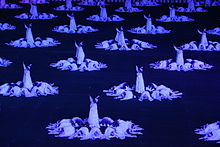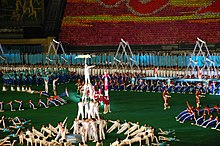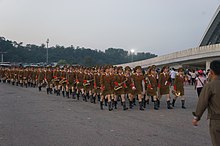Arirang Mass Games
| Arirang Mass Games 아리랑 축제 | |
|---|---|
 Arirang Festival mass games display in Pyongyang, North Korea | |
| Status | Irregularly held, usually held every year |
| Genre | Mass gymnastics, festival |
| Frequency | Annually |
| Venue | Rungrado 1st of May Stadium |
| Location(s) | Pyongyang, North Korea |
| Country | North Korea |
| Years active | 2002—2013; 2018—2020[1] |
| Arirang Mass Games | |
| Chosŏn'gŭl | |
|---|---|
| Hancha | 아리랑 祝祭 |
| Revised Romanization | Arirang chukje |
| McCune–Reischauer | Arirang ch'ukche |
The Grand Mass Gymnastics and Artistic Performance Arirang[2] (Korean: 아리랑 축제), also known as the Arirang Mass Games,[3] or the Arirang Festival[4] is a mass gymnastics and artistic festival held in the Rungrado 1st of May Stadium in Pyongyang, North Korea. The games usually take place in August or September. The Arirang Mass Games were held annually between 2002 and 2013, with the exception of 2006. After a five-year hiatus, Mass Games returned for a performance entitled 'The Glorious Country' in 2018.
According to the Russian News Agency "TASS", "Arirang is a gymnastics and artistic festival, known as mass games. The extravaganza unfolds an epic story of how the Arirang nation of Korea, a country of morning calm, in the Orient put an end to the history of distress and rose as a dignified nation with the song 'Arirang'. The Arirang performance has been included in the Guinness Book of Records."[5]
History
[edit]
The name refers to "Arirang", a Korean folk story about a young couple who are torn apart, here intended to represent the division of Korea.
The festival was held annually between 2002 and 2013, with the exception of 2006. In 2007, Roh Moo-hyun became the first South Korean President to attend the games during the 2007 inter-Korean summit. The mass games were not held in 2014, 2015, 2016, and 2017.[6] In recent years, foreign tourists have been allowed to watch one of the many performances.[7]
The mass games returned after a five-year hiatus, taking place from September 9 through September 30, 2018. The new performance was called "The Glorious Country" (빛나는 조국). On September 19, South Korean President Moon Jae-in attended the Mass Games with Supreme Leader Kim Jong-un and addressed the crowd of 150,000.[8]
The 2019 edition was named "People's Country" or "The Land of The People" (인민의 나라).[9]
A further mass games event was scheduled to begin on August 15, 2020, playing weekly until the October 10. These dates were chosen to coincide with the 75th anniversaries of Liberation Day and Party Foundation Day.[10] The event was eventually held from October 11 through October 31, and was entitled "Great Leadership" (위대한 향도). Due to the COVID-19 pandemic, the country's borders were closed to foreigners at the time.[11][12]
There were no mass games in 2021.[13]
Iconography
[edit]The Mass Games possess an important ideological character setting out the legacy and political narratives of the North Korean state, with emphasis placed upon Workers' Party of Korea, its armed forces, Kim Il-sung and Kim Jong-il.[14]
These messages may not be clear to foreign spectators, who are not aware of North Korean iconography: a rising sun symbolizes Kim Il-sung. When a gun is shown, it signifies the gun which Kim Il-sung gave to his son Kim Jong-il. The colour red, particularly in flowers, stands for the working class, and the colour purple and red flowers represent Kim Il-sung (as the flower Kimilsungia is a purple orchid and the flower Kimjongilia is a red begonia). A snowy mountain with a lake represents Mount Paektu, a traditional symbol of Korea and where Kim Jong-il is said to have been born in a log cabin.[citation needed]
Participants
[edit]

From as young as five years old, North Korean citizens are selected based on skill level to serve for the Arirang Festival for many years. In most cases this will be the way of life for them until retirement.[15] They are students from eight schools in Pyongyang, and each school has its own colours.[citation needed] These are
- 서성 Seoseong (red and yellow)
- 평천 Pyeongcheon (green and white)
- 대동강 Daedonggang (blue and yellow)
- 모란봉 Moranbong (red and white)
- 보통강 Botonggang (blue and white)
- 만경대 Mangyeongdae (red and white)
- 대성 Daeseong (blue and white)
- 락랑 Rakrang (red and yellow)
Events
[edit]
The opening event of the two-month festival are the mass games, which are famed for the huge mosaic pictures created by more than 30,000[16] trained school children, each holding up coloured cards, in an event known in the West as a card stunt, accompanied by complex and highly choreographed group routines performed by tens of thousands of gymnasts and dancers.
World record
[edit]In August 2007, the Arirang Mass Games were recognized by Guinness World Records as the largest gymnastic display with 100,090 participants at the May Day Stadium in Pyongyang.[17]
See also
[edit]- Sport in North Korea
- A State of Mind – UK produced documentary (VeryMuchSo productions and Koryo Tours) about child gymnasts in training for the Mass Games
- Juche
- Propaganda in North Korea
- Tourism in North Korea
- Peace Treaty on Korean Peninsula
References
[edit]- ^ abc News (ed.). "North Korea to hold 'Mass Games' after 5-year hiatus". Retrieved 29 January 2021.
- ^ Merkel, Udo. "'The grand mass gymnastics and artistic performance Arirang' (2002–2012): North Korea's socialist–realist response to global sports spectacles." The International Journal of the history of Sport 30.11 (2013): 1247–58.
- ^ CENTER, NCC. "The Arirang Mass Games of North Korea 朝鮮民主主義人民共和国のアリラン祭 Rüdiger Frank."
- ^ Jung, Hyang Jin. "Jucheism as an Apotheosis of the Family: The Case of the Arirang Festival." Journal of Korean Religions 4.2 (2013): 93–122.
- ^ "DPRK prepares for celebration of victory in the 1950–1953 war under rain". Russian News Agency "TASS". Archived from the original on 21 October 2018. Retrieved 16 March 2015.
- ^ Leo Byrne (6 February 2014). "No Arirang Mass Games this year". NK News. Retrieved 6 February 2014.
- ^ "North Korea halts showcase mass games due to flood". Reuters. 27 August 2007. Archived from the original on 29 August 2007.
- ^ "Moon, Kim attend North Korea's mass gymnastics performance". The Korea Times. 19 September 2018. Retrieved 7 May 2020.
- ^ "The Mass Games are confirmed". Uri Tours. 7 July 2018.
- ^ Rowan (18 February 2020). "Mass Games to Return for 2020 North Korean Tours". Young Pioneer Tours. Retrieved 18 February 2020.
- ^ Colin Zwirko (10 October 2020). "North Korea's mass games will celebrate 'great leadership' starting on Monday".
- ^ "Mass Games 2020 Photos Released!". Young Pioneer Tours. October 2020.
- ^ Colin Zwirko (13 November 2021). "Why North Korea won't hold its 'mass games' spectacle this year". NK News.
- ^ "What are North Korea's Mass Games?". Visit North Korea. 22 March 2019. Retrieved 22 May 2019.
- ^ Filipetti, Jenny (21 October 2011). "Human billboard paintings at North Korea mass games". Design Boom. Retrieved 10 November 2023.
- ^ Watts, Jonathan (1 October 2005). "Welcome to the strangest show on earth". The Guardian.
- ^ "Largest gymnastic display".
Further reading
[edit]- Burnett, Lisa (2013). "Let Morning Shine over Pyongyang: The Future-Oriented Nationalism of North Korea's Arirang Mass Games". Asian Music. 44 (1): 3–32. doi:10.1353/amu.2013.0010. ISSN 1553-5630. S2CID 191491691.
- "Interview with Song Sok Hwan, Vice Cultural Minister: Re-extended 'Arirang' Performance Is Intended to Give Fresh Impetus to Economic Renovation in DPRK". The People's Korea. 13 July 2002. Archived from the original on 12 August 2003. Retrieved 22 October 2018.
- Kim Jong-il (15 August 2002). The Grand Mass Gymnastics and Artistic Performance Arirang is a World-class Masterpiece Representative of the New Century (PDF). Pyongyang: Foreign Languages Publishing House. Archived from the original (PDF) on 25 September 2016. Retrieved 15 May 2017.
- Song Mo Kim; Song Il Thak; Chol Man Kim (2002). Mass Gymnastics in Korea. Pyongyang: Foreign Languages Publishing House. OCLC 499981837. Archived from the original on 12 August 2017.
External links
[edit]- Werner Kranwetvogel with Koryo Tours Massgames Pictures
- DPRK 360 Video and 360 VR of the Mass Games
- Steve Gong Arirang Festival, North Korea 2008
- Arirang Festival 1stopkorea.com
- Mass Gymnastics and Artistic Performance "Arirang" picture album Archived 16 July 2015 at the Wayback Machine at Naenara
- Mass Gymnastics in Korea picture album Archived 4 March 2016 at the Wayback Machine at Naenara
- A slide show about Arirang Festival 2012 (in German)
- Propaganda in North Korea
- Festivals in North Korea
- Culture of North Korea
- Tourist attractions in Pyongyang
- April events
- Sport in North Korea
- Sport in Pyongyang
- Culture in Pyongyang
- Politics and sports
- Sports festivals in North Korea
- Annual sporting events in North Korea
- Recurring sporting events established in 2002
- 2002 establishments in North Korea
- Recurring sporting events disestablished in 2013
- 2013 disestablishments in North Korea
